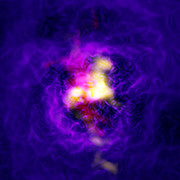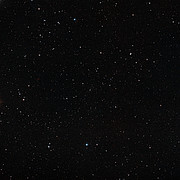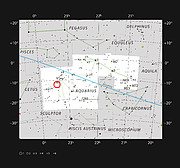Pressemeddelelse
Galaktisk springvand fundet af ALMA og MUSE
6. november 2018
Der vælder et enormt springvand af gasmolekyler ud fra det sorte hul i centrum af den klareste af galakserne i galaksehoben Abell 2597, og aldrig før har forskerne set både indfald af stof, og den udstrømmende mængde i den samme galakse. Det er observationer med ALMA og data fra spektrografen MUSE på ESOs VLT, som er bag den nye opdagelse.
Blot en milliard lysår borte i den nære galaksehob Abell 2597, fosser et enormt galaktisk springvand. Det er et tungt sort hul i hjertet af galaksen, som pumper store faner af kold molekylær gas ud i rummet. Derefter falder gasserne tilbage mod det sorte hul som en regn af stof eller et intergalaktisk skybrud . Aldrig før har man set både udbrud og indsugning af stof ved den samme kosmiske kilde, og det hele foregår indenfor de inderste 100 000 lysår ved den klareste galakse i hoben Abell 2597.
"Det er muligvis det første system, hvor vi har fundet klare beviser for både kold molekylær gas, som strømmer ind imod det sorte hul og for den strøm af gasser, som det sorte hul udspyr," forklarede Grant Tremblay fra Harvard-Smithsonian Center for Astrophysics og som er tidligere fellow hos ESO og leder af forskerholdet. "Det supertunge sorte hul i centrum af denne enorme galakse fungerer som den mekaniske pumpe i et springvand."
Tremblay of forskerne brugte ALMA for at spore positioner og bevægelse for molekyler af kulilte inde i tågen. Disse kolde molekyler, med temperaturer ned omkring minus 250-260°C kan ses i fald indad imod det sorte hul. Forskerholdet brugte også data fra instrumentet MUSE på ESOs Very Large Telescope til at spore varmere gasser - det, som slynges ud fra det sorte hul i form af jets.
"Det helt enestående her er, at vi får en meget detaljeret koblet analyse af kilden ved at bruge data fra ALMA og MUSE," forklarede Tremblay. "De to anlæg i kombination er utroligt stærke."
Tilsammen danner disse to datasæt et fuldstændigt billede af hele processen; kold gas falder ind imod det sorte hul, får det til at gå i udbrud, og forårsager hurtige jets af lysende plasma ud i tomrummet. Disse jets sprøjter så ud fra det sorte hul som en bemærkelsesværdig galaktisk fontæne. Uden håb om at kunne undslippe galaksens faste greb med tyngdekraften, køler plasmaet ned, og regner i den sidste ende ned over det sorte hul, hvor processen så kan begynde forfra.
Denne hidtil usete observation kan belyse galaksernes livscyklus. Forskerne spekulerer over, om ikke denne proces er ganske almindelig, og på samme tid vigtig for at forstå galaksedannelse. Tidligere har andre observeret indfald og udsendelse af kold molekylær gas, men det er første gang begge dele er observeret i det samme system, så vi nu er sikre på, at de to ting hænger sammen som en enorm samlet proces.
Abell 2597 befinder sig i stjernebilledet Aquarius, og hoben har navnet fordi den findes i Abell catalogue of rich clusters of galaxies. Dette katalog indeholder også hobe som for eksempel Fornaxhoben, Herculeshoben og Pandoras hob.
Mere information
Forskningsresultaterne her er offentliggjort i en artikel med titlen “A Galaxy-Scale Fountain of Cold Molecular Gas Pumped by a Black Hole”, i tidsskriftetThe Astrophysical Journal.
Forskerholdet består af G. R. Tremblay (Harvard-Smithsonian Center for Astrophysics, Cambridge, USA; Yale Center for Astronomy and Astrophysics, Yale University, New Haven, USA), F. Combes (LERMA, Observatoire de Paris, Sorbonne University, Paris, Frankrig), J. B. R. Oonk (ASTRON, Dwingeloo, Nederlandene; Leiden Observatory, Nederlandene), H. R. Russell (Institute of Astronomy, Cambridge University, UK), M. A. McDonald (Kavli Institute for Astrophysics and Space Research, Massachusetts Institute of Technology, Cambridge, USA), M. Gaspari (Department of Astrophysical Sciences, Princeton University, USA), B. Husemann (Max-Planck-Institut für Astronomie, Heidelberg, Tyskland), P. E. J. Nulsen (Harvard-Smithsonian Center for Astrophysics, Cambridge, USA; ICRAR, University of Western Australia, Crawley, Australia), B. R. McNamara (Physics & Astronomy Department, Waterloo University, Canada), S. L. Hamer (CRAL, Observatoire de Lyon, Université Lyon, Frankrig), C. P. O’Dea (Department of Physics & Astronomy, University of Manitoba, Winnipeg, Canada; School of Physics & Astronomy, Rochester Institute of Technology, USA), S. A. Baum (School of Physics & Astronomy, Rochester Institute of Technology, USA; Faculty of Science, University of Manitoba, Winnipeg, Canada), T. A. Davis (School of Physics & Astronomy, Cardiff University, UK), M. Donahue (Physics and Astronomy Department, Michigan State University, East Lansing, USA), G. M. Voit (Physics and Astronomy Department, Michigan State University, East Lansing, USA), A. C. Edge (Department of Physics, Durham University, UK), E. L. Blanton (Astronomy Department and Institute for Astrophysical Research, Boston University, USA), M. N. Bremer (H. W. Wills Physics Laboratory, University of Bristol, UK), E. Bulbul (Harvard-Smithsonian Center for Astrophysics, Cambridge, USA), T. E. Clarke (Naval Research Laboratory Remote Sensing Division, Washington, DC, USA), L. P. David (Harvard-Smithsonian Center for Astrophysics, Cambridge, USA), L. O. V. Edwards (Physics Department, California Polytechnic State University, San Luis Obispo, USA), D. Eggerman (Yale Center for Astronomy and Astrophysics, Yale University, New Haven, USA), A. C. Fabian (Institute of Astronomy, Cambridge University, UK), W. Forman (Harvard-Smithsonian Center for Astrophysics, Cambridge, USA), C. Jones (Harvard-Smithsonian Center for Astrophysics, Cambridge, USA), N. Kerman (Yale Center for Astronomy and Astrophysics, Yale University, New Haven, USA), R. P. Kraft (Harvard-Smithsonian Center for Astrophysics, Cambridge, USA), Y. Li (Center for Computational Astrophysics, Flatiron Institute, New York, USA; Department of Astronomy, University of Michigan, Ann Arbor, USA), M. Powell (Yale Center for Astronomy and Astrophysics, Yale University, New Haven, USA), S. W. Randall (Harvard-Smithsonian Center for Astrophysics, Cambridge, USA), P. Salomé (LERMA, Observatoire de Paris, Sorbonne University, Paris, Frankrig), A. Simionescu (Institute of Space and Astronautical Science [ISAS], Kanagawa, Japan), Y. Su (Harvard-Smithsonian Center for Astrophysics, Cambridge, USA), M. Sun (Department of Physics and Astronomy, University of Alabama in Huntsville, USA), C. M. Urry (Yale Center for Astronomy and Astrophysics, Yale University, New Haven, USA), A. N. Vantyghem (Physics & Astronomy Department, Waterloo University, Canada), B. J. Wilkes (Harvard-Smithsonian Center for Astrophysics, Cambridge, USA) og J. A. ZuHone (Harvard-Smithsonian Center for Astrophysics, Cambridge, USA).
ESO er den fremmeste fællesnationale astronomiorganisation i Europa, og verdens langt mest produktive jordbaserede astronomiske observatorium. 16 lande er med i ESO: Belgien, Danmark, Finland, Frankrig, Irland, Italien, Nederlandene, Polen, Portugal, Spanien, Sverige, Schweiz, Storbritannien, Tjekkiet, Tyskland og Østrig, og desuden værtsnationen Chile. Australien er med som strategisk partner. ESO har et ambitiøst program, som gør det muligt for astronomer at gøre vigtige videnskabelige opdagelser. Programmet har focus på design, konstruktion og drift af stærke jordbaserede observatorier. Desuden har ESO en ledende rolle i formidling og organisering af samarbejde omkring astronomisk forskning. ESO driver tre enestående observatorier i verdensklasse i Chile: La Silla, Paranal og Chajnantor. På Paranal driver ESO VLT, Very Large Telescope, som er verdens mest avancerede observatorium for synligt lys, samt to oversigtsteleskoper. VISTA, som observerer i infrarødt, er verdens største oversigtsteleskop, og VLT Survey Teleskopet er det største teleskop bygget til at overvåge himlen i synligt lys. ESO er en af de største partnere i ALMA, som er det største eksisterende astronomiprojekt. For tiden bygges ELT, et 39 m optisk og nærinfrarødt teleskop på Cerro Armazones, tæt ved Paranal. Det bliver "verdens største himmeløje".
Links
Kontakter
Grant Tremblay
Harvard-Smithsonian Center for Astrophysics
Cambridge, USA
Tel: +1 207 504 4862
E-mail: grant.tremblay@cfa.harvard.edu
Francoise Combes
LERMA, Paris Observatory
Paris, France
E-mail: francoise.combes@obspm.fr
Calum Turner
ESO Public Information Officer
Garching bei München, Germany
Tel: +49 89 3200 6670
E-mail: pio@eso.org
Ole J. Knudsen (Pressekontakt Danmark)
ESOs formidlingsnetværk
og Aarhus Space Centre, Aarhus Universitet
Aarhus, Danmark
Tel: +45 8715 5597
E-mail: eson-denmark@eso.org
Om pressemeddelelsen
| Pressemeddelelse nr.: | eso1836da |
| Navn: | Abell 2597 |
| Type: | Local Universe : Galaxy : Grouping : Cluster |
| Facility: | Atacama Large Millimeter/submillimeter Array, Very Large Telescope |
| Science data: | 2018ApJ...865...13T |
Our use of Cookies
We use cookies that are essential for accessing our websites and using our services. We also use cookies to analyse, measure and improve our websites’ performance, to enable content sharing via social media and to display media content hosted on third-party platforms.
ESO Cookies Policy
The European Organisation for Astronomical Research in the Southern Hemisphere (ESO) is the pre-eminent intergovernmental science and technology organisation in astronomy. It carries out an ambitious programme focused on the design, construction and operation of powerful ground-based observing facilities for astronomy.
This Cookies Policy is intended to provide clarity by outlining the cookies used on the ESO public websites, their functions, the options you have for controlling them, and the ways you can contact us for additional details.
What are cookies?
Cookies are small pieces of data stored on your device by websites you visit. They serve various purposes, such as remembering login credentials and preferences and enhance your browsing experience.
Categories of cookies we use
Essential cookies (always active): These cookies are strictly necessary for the proper functioning of our website. Without these cookies, the website cannot operate correctly, and certain services, such as logging in or accessing secure areas, may not be available; because they are essential for the website’s operation, they cannot be disabled.
Functional Cookies: These cookies enhance your browsing experience by enabling additional features and personalization, such as remembering your preferences and settings. While not strictly necessary for the website to function, they improve usability and convenience; these cookies are only placed if you provide your consent.
Analytics cookies: These cookies collect information about how visitors interact with our website, such as which pages are visited most often and how users navigate the site. This data helps us improve website performance, optimize content, and enhance the user experience; these cookies are only placed if you provide your consent. We use the following analytics cookies.
Matomo Cookies:
This website uses Matomo (formerly Piwik), an open source software which enables the statistical analysis of website visits. Matomo uses cookies (text files) which are saved on your computer and which allow us to analyze how you use our website. The website user information generated by the cookies will only be saved on the servers of our IT Department. We use this information to analyze www.eso.org visits and to prepare reports on website activities. These data will not be disclosed to third parties.
On behalf of ESO, Matomo will use this information for the purpose of evaluating your use of the website, compiling reports on website activity and providing other services relating to website activity and internet usage.
Matomo cookies settings:
Additional Third-party cookies on ESO websites: some of our pages display content from external providers, e.g. YouTube.
Such third-party services are outside of ESO control and may, at any time, change their terms of service, use of cookies, etc.
YouTube: Some videos on the ESO website are embedded from ESO’s official YouTube channel. We have enabled YouTube’s privacy-enhanced mode, meaning that no cookies are set unless the user actively clicks on the video to play it. Additionally, in this mode, YouTube does not store any personally identifiable cookie data for embedded video playbacks. For more details, please refer to YouTube’s embedding videos information page.
Cookies can also be classified based on the following elements.
Regarding the domain, there are:
- First-party cookies, set by the website you are currently visiting. They are stored by the same domain that you are browsing and are used to enhance your experience on that site;
- Third-party cookies, set by a domain other than the one you are currently visiting.
As for their duration, cookies can be:
- Browser-session cookies, which are deleted when the user closes the browser;
- Stored cookies, which stay on the user's device for a predetermined period of time.
How to manage cookies
Cookie settings: You can modify your cookie choices for the ESO webpages at any time by clicking on the link Cookie settings at the bottom of any page.
In your browser: If you wish to delete cookies or instruct your browser to delete or block cookies by default, please visit the help pages of your browser:
Please be aware that if you delete or decline cookies, certain functionalities of our website may be not be available and your browsing experience may be affected.
You can set most browsers to prevent any cookies being placed on your device, but you may then have to manually adjust some preferences every time you visit a site/page. And some services and functionalities may not work properly at all (e.g. profile logging-in, shop check out).
Updates to the ESO Cookies Policy
The ESO Cookies Policy may be subject to future updates, which will be made available on this page.
Additional information
For any queries related to cookies, please contact: pdprATesoDOTorg.
As ESO public webpages are managed by our Department of Communication, your questions will be dealt with the support of the said Department.





